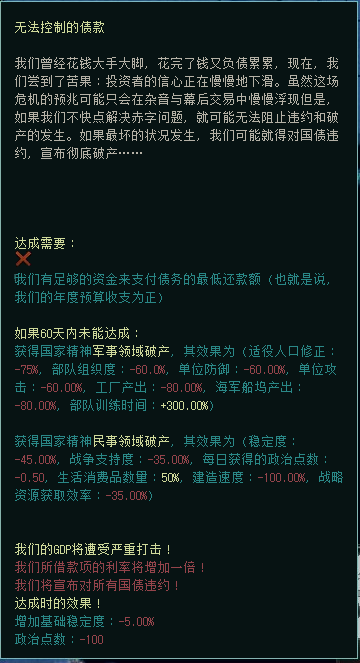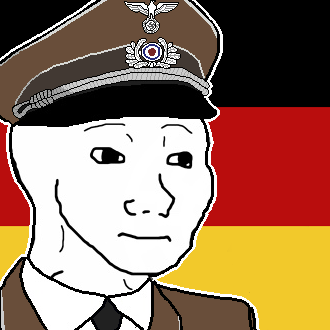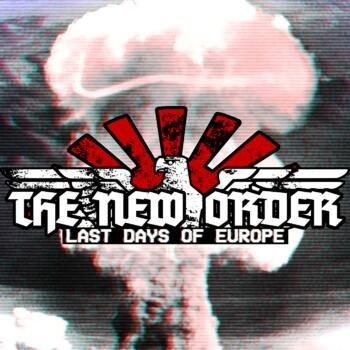TNO更新日志#6 |死亡与纳税
Development Update VI: Death & Taxes
TNO更新日志6: 死亡与纳税
Hey guys, NuclearWaffles and Kracc here for a development update! Yes, we have a real progress report! You may (or may not) remember us from the brief Societal Development update tacked on to the end of the US diary, and if you’ve read it, you might have a pretty good idea of what’s coming up next in this update. That’s right, it’s time for more mechanics development! Yay! [cue confetti]
嘿伙计们, NuclearWaffles与Kracc来为大家奉上新一期的更新日志啦!是的,我们有了一篇干货慢慢的日志!你们也许记得(也可能并不记得)我们曾经在美国日志最后的社会发展更新部分简短的亮相,如果你读过那篇日志的话,就一定能够十分清晰地理解这篇更新日志接下来的内容了。是的,是时候看看更多的新机制了!耶![抛出彩带]
I’m sure almost everyone agrees that one of the most problematic mechanics in HOI4 right now is how civilian and military industries work, and specifically how they grow/are maintained. Once you build a military or civilian factory, they essentially require no upkeep whatsoever--no oil, no steel, no nothing. Yes, they contribute to total factory count when it comes to calculating consumer goods, but that’s an obstacle easily overcome with stacking modifiers or just outbuilding the penalties.
我很确信,几乎所有人都会同意钢4目前问题最大的机制就是民用和军用工厂的运作方式,尤其是它们的增长以及维护。你建造了一座军用或民用工厂,然后它们就不再需要任何的维护了——不用油,不用钢,什么都不用。诚然,它们会在计算生活消费品时计入总工厂数之内,但这个障碍实在太容易克服了,只需要堆buff或者单纯多造工厂来盖过消费品惩罚就可以了。
Part of this issue stems from the fact that money (and basic economics) are not represented at all in HOI4. That may work just fine for a 5-6 year run, but for a mod such as TNO with a 20-year time span, it simply won’t do, especially for a Cold War-esque setting.
这个问题的主要来源之一是钢4根本没有表现出任何形式的货币(以及基本的经济体系)。对五六年的游戏流程来说这可能足够了,但对TNO这样跨度长达20年的mod来说,这当然是不行的,更何况TNO的背景设定还是冷战时代。
So, we simply revamped the entire system
所以,我们干脆把整个系统推倒重做了。

Your country now has a responsibility to balance its budget (among other things). Before we go any further, I’d like to mention that we’ve debated for a long time whether we want an abstract “money” number ala DH or HOI3 or go with real-life monetary amounts, and ultimately settled on the latter. We also decided to use 1960 OTL USD for all figures, and keep it consistent with time (i.e. not modeling inflation) for several reasons.
你的国家现在得负责平衡预算(和一些其他东西)。在进一步深入讨论之前,我想提到的一点是,我们就要使用DH或者钢3那样的抽象“金钱”单位还是现实中的货币数额进行了很久的争论,最终决定采用后者。我们同时还决定用本位面1960年的美元作为所有数据的单位,并且出于一些原因令其价格随时间恒定(也就是说不计算通货膨胀)。
USD is the most consistent currency in both TNO and OTL when it comes to measuring value--there’s a reason everybody pegs their fiat currencies to USD It’s much easier to develop with real figures rather than some abstract money variable Inflation, while a cool mechanic, is ultimately a lot of feature bloat for little depth gain fuck you i’m not going to try converting every currency back and forth
美元在TNO世界和本位面都能算是最稳定的计算货币——每个国家都将其法定货币与美元挂钩是有一定原因的。使用真实存在的货币来开发比用一些抽象的货币来体现通货膨胀要方便多了,尽管后者是一个很酷的机制,但它堆叠了一大堆臃肿的特性却只能获得极小的收益,干你X的我真的不想再去来回换算那一大堆货币了
This screen might be a little intimidating just to stare at, so let’s walk through this thing section by section.
这个界面光是看着都让人感觉有点心慌,所以我们分一节一节地来看吧
GDP
Your GDP, or Gross Domestic Product, represents the total value of goods and services produced, given, or otherwise used in your nation within 1 calendar year. To put it simply, it’s how “big” your economy is. It grows at a certain rate based on economic health indicators, though that’s simply abstracted as a single variable that changes as an effect in TNO.
你的GDP,或者说国民生产总值,是你的国家内部每年通过商品生产,服务业,进口,或者通过其他方式利用的价值。简单来讲GDP就是在表示你的经济规模有多“大”。GDP每年会根据经济的健康程度得到一定规模的增长,只不过在TNO里这个指标被抽象成了一个会随效果变化而变化的变量。
It’s important to note that your GDP isn’t the amount of money you can just up and spend every year. You can’t just take control of every single cent of money in your country’s economy and use it for whatever you want (regardless of how hard you try, Goering/NPP-L/other people with REALLY GOOD IDEAS).
你需要明白一个要点,就是GDP并不代表你每年有多少钱可以拿去花。你不能从国家经济体系中榨出每一分钱然后想往哪花就往哪花(再怎么努力都不行,说的就是你们,戈林/左翼NPP/和其他异想天开者)
Which brings us to:
因此我们需要引入:
INCOME
收入
In order to actually make use of your GDP, you need to tax your people in order to gain money to build things like schools and roads. Or guns and tanks, if you’d prefer. The Annual Income Rate is the proportion of your GDP that you can use for government spending, and it is determined by your tax laws.
为了让你能够实际运用GDP,你需要从国民身上收取税金来建造学校或者道路之类的东西。或者如果你喜欢的话,也可以拿来造枪造坦克。年收入率是每年GDP中能拿来当作政府开支的资金比例,由你的税收法案来决定。


There’s also Other Income, which represents all other regular sources of income, such as trade deals, war reparations, or any things that aren’t taxes.
还有其他收入,包括一切其他正规途径带来的收入,比如贸易协定,战争赔款,以及其他所有税收以外的途径。
So, what exactly can you spend your hard-earned money on?
那么,你可以把自己的血汗钱花到什么地方呢?
EXPENDITURES
开支
A lot of things, actually. And many of those things are not optional.
实际上,可以花在很多地方。而且其中很多都是必须花的。
Spending is broken down into 4 different categories: Civilian, Military, Construction & Trade, and Other.
开支被分为四大类:民事,军事,建设与贸易,其他。
Civilian spending represents the money your government puts towards domestic improvement programs and welfare, such as pensions, healthcare, education, police, and so on. Really, it’s anything that doesn’t involve shooting at other people. Er, the people of other nations. Notice how spending is proportional to your GDP: it ensures that even small nations can implement expensive policies if they have the capital, and that big nations won’t have such an easy time implementing them.
民事开支表示的是你的政府为了改善人民生活和福利而花费的钱,比如退休金,医保,教育,公安等等。其实就是任何不涉及对人开枪的事情。呃,对其他国家的人开枪。要注意开支是与你的GDP成正比的:这使得就算是小国也能在有钱的前提下推行花费高昂的政策,而大国在执行类似的政策时就必须多加斟酌了。


Military spending is for all the guns, bullets, tanks, planes, sun guns, or other weapons your country needs to destroy its enemies. It’s further broken down into three subcategories: Personel (you can’t just have soldiers run on sheer willpower and grit ), Production (turns out, guns cost money), and Nuclear Arsenal (turns out, bigger guns cost bigger money). With this, large militaries will now be difficult to maintain without the proper financial and industrial base, and downsizing after a large war actually has some benefits!
军事开支是花在一切枪支、弹药、坦克、飞机、太阳炮,或者任何你的国家在摧毁敌人时需要用到的武器。它被细分为三个子类:兵员开销(你不能让士兵仅凭纯粹的意志力与勇气来作战),军工生产(很显然,造枪也是要花钱的)以及核武器库(显然,越大的枪就越贵)。有了这个系统,没有合理运营财政和一定工业基础的国家就会很难维持大规模的军队,大战之后裁撤军队将能带来一些好处!


Construction & Trade spending represents the funding your country’s government puts towards national construction projects and foreign resource trade. All civilian factories are now, by default, unavailable for use unless you spend money to do so. For each 5% of your GDP you spend on construction, 10% of your civilian factories are freed up for use, with the cost modified by laws. To prevent any exploiting of monthly calculations, changing the law costs 50pp per level.
建设与贸易开支表示的是你的政府花费在国内建设和对外资源贸易上面的开销。现在,在默认条件下,每间民用工厂都需要花钱维护才能开工。每10%的民用工厂都需要花费GDP的5%来维持生产,法律可以改变这个花费。为了防止利用每月刷新来投机取巧,改变法案需要花费50政治点数。

A note on trade: unfortunately, our experience with the trade system has been that the civilian factory costs are hardcoded, meaning that while we can add a variable cost to trade deals, we can’t remove the civilian factory costs, and so we decided to roll the construction and trade budgets together and simply make the best of the situation. This way, trade is still linked to the new economic system, if somewhat indirectly.
贸易系统的注意事项:不幸的是,我们在贸易系统方面的经验已经证明,资源交易的民用工厂花费是被硬编码的,这意味着尽管我们可以给贸易协定增加变量花费,但却无法彻底移除民用工厂的花费,所以我们将建设与贸易预算合二为一,尽可能完美地解决了问题。在这种方案下,贸易仍然是与新经济系统挂钩的,只不过没那么直接了。
Finally, Other spending is simply the expenditure version of Other Income, a catch-all for all other running costs. Examples include programs added by focus, maintaining the Gibraltar dam, and modernization programs.
最后,其他开支就是其他收入的支出版本,是所有其他支出的集合。例如那些国策项目的花费,维持直布罗陀大坝的花费,以及进行现代化所需的资金。
All these expenditures tie very nicely into the laws system, where, as you may have noticed above, certain laws now modify spending or income.
所有这些开支都与法案系统紧密地联系了起来,你之前可能已经注意到了,某些特定法案现在会调整收入或支出。
Whew! That’s a lot of things to spend money on! So, what exactly happens if you run over budget?
喔!有很多地方可以花钱哦!那如果预算枯竭了又会发生什么呢?
DEBT & DEFICIT
债务与赤字
Fortunately, debt on a national level works a little differently than it does on smaller scales. There’s nothing shameful or inherently negative about going into debt as a nation--as a matter of fact, most nations in TNO at game start are in debt.
幸运的是,国债与小规模债务的运作方式略有不同。作为一个国家,负债并没有什么可耻的,也没有什么内在的负面影响——事实上,TNO的大多数国家在游戏开始时都负债累累。
If your nation ever starts running a deficit (which will be quite often), it’ll start borrowing from other nations, their own citizens, public & private banks, or a combination of all 3. This process is all abstracted and consolidated into a singular National Debt value to prevent excessive complexity.
如果你的国家开始出现赤字(这将是非常普遍的),它将开始从其他国家、本国公民或公共和私人银行借款,或者这三者的结合。这一过程都被抽象并合并为一个单一的国家债务值,以防止过于复杂。
As an added bonus, running a deficit actually provides your GDP a small growth bonus, simulating the increased flow of goods and currency in the economy. So deficit spending can actually have a lot of benefits for most economies, assuming you know what you’re doing. If this paragraph offends you, please let me know so I can ban you for not being a Keynesian. If this paragraph really offends you, then you’re probably an Austrian School economist and should seriously rethink your life choices.
赤字实际上为GDP提供了一个小的增长额外奖励,它模拟了经济中商品和货币流动的增加。因此,如果你知道自己在做什么,那么赤字支出实际上对大多数经济体都有很多好处。如果这段话冒犯到了你,那么请告诉我,这样我就可以因为你不是凯恩斯主义者而在服务器上踢掉你了。如果这段话非常冒犯到了你,那么你可能是奥地利学派的经济学家,也许你应该认真反思下自己的人生选择了。
Anyway, that sounds really great! What’s the catch?
不管怎样,这听起来真棒!但问题是什么?
This debt isn’t interest free. Every month, your nation must pay a certain percentage of interest on that debt, as determined by the Interest Rates: another general abstraction that represents how investor confidence in the stability of your nation’s economy and how many returns they’re willing to give up in exchange for the stability of their investment--in short, how willing investors are to take your nation “on its word”.
这种债务不是无息的。每个月,你的国家必须支付一定比例的利息债务,这是由利率决定的:另一个抽象的值代表着投资者对于你的国家经济的稳定状况的信心,以及他们愿意放弃多少回报来换取投资的稳定——简而言之, 投资者有多愿意相信你们国家的“承诺”。

TEMPORARY MODIFIERS & LIQUID RESERVE
临时调整和流动准备金
Now, up to this point, the economy may seem like something that just… happens. Something that you don’t have any control over, just designed to screw you over. Well, don’t worry, because you can
现在,到目前为止,经济似乎只是……一些正在发生的事情,它是你无法控制的东西,他们的存在只是为了把你搞砸。但别担心,因为你能
c l i c k b u t t o n s
点 按 钮

And I know how much you HOI4 players love clicking buttons.
我知道你们这些钢4玩家是多么的喜欢点按钮。
The military, civilian, and construction budget buttons should all be fairly self explanatory. They provide either temporary buffs/maluses in exchange for spending modifiers in the case of military & civilian budgets, or permanent spending changes in the case of the construction budget.
军事、民用和建筑预算按钮都应该相当容易理解。它们要么提供临时的增益/减成,以换取军事和民用预算中的支出调整,要么提供永久性的支出更改,以换取建筑预算中的支出更改。

The liquid reserve buttons, along with the reserve itself, deserve a little more explanation. Your country’s Liquid Reserve represents the total amount of cash/gold/MEFO bills/cocaine/shovels/other forms of currency your nation has on-hand. For the most part, it’s mutually exclusive with National Debt, as any budget surplus will first go towards repaying your debt before flowing into your coffers. It’s possible, however, to gain reserves from various focus, event, or decision effects.
流动储备金按钮,以及储备金本身,值得更多的解释。你的国家的流动储备金代表了你手头的现金/黄金/梅福券/可卡因/铲子/其他货币的总量。在很大程度上,它与国家债务是相互排斥的,因为任何预算盈余都将首先用于偿还债务,然后才会流入国库。然而,从各种焦点、事件或决策效果中获得准备金是可能的。
Now, onto the buttons. The first button will use your reserve as an economic stimulus, growing your GDP at a ratio of 1$ for every 3$ invested, while the second button will immediately put all of your current reserves towards paying off your national debt, which can be very handy when it comes to crises like
现在,按下按钮。第一个按钮将使用你的储备来进行经济刺激,以每投资3美元增长1美元的比率增长你的GDP,而第二个按钮将立即把你所有的当前储备用于偿还你的国家债务,这对于我们要面对的危机来说非常方便,比如说


BANKRUPTCY
破产
Remember how I said debt is okay earlier? Well, it’s only okay up to a certain extent. All those banks lending you money and all those citizens buying bonds are going to expect some returns on their investment. If the debt suddenly shoots up, or the GDP crashes overnight, or interest rates skyrocket because of some external factor, what seemed like manageable debt might suddenly take up your entire budget. You need to make your minimum payments one way or another, and if you can’t, then, well, an asset that can’t guarantee returns is a very risky one and that’s what your country has just turned into.
还记得我之前说债务没什么吗? 嗯,这在一定程度上是成立的。所有那些向你提供贷款的银行和购买债券的公民们都希望获得一定的投资回报。如果债务突然飙升,或者GDP在一夜之间崩溃,或者由于某些外部因素导致利率飙升,看似可控的债务可能会突然占用你的全部预算。你需要以这种或那种方式支付最低支付额,如果你不能,那么,一项无法保证回报的资产是非常危险的,而这正是你的国家正在陷入的情况。
A financial crisis will start, which might be preventable in its early stages, but as it progresses, the debt, panic selling, and crashes start to add up. GDP falls and interest rates rise. Things will start bad, and get really bad.
一场金融危机将会开始,这在早期是可以避免的,但是随着危机的发展,债务、恐慌性抛售和崩溃将会增加。GDP下降,利率上升。事情会开始变得很糟糕,而且会变得非常糟糕。
And boy, can things get really bad.
而且朋友,事情会变得非常糟糕。

(screw you guys for thinking this was just a Goering leak, seriously)
(该死,你们这些家伙以为这只是戈林的leak嘛,认真点)
CIV GROWTH
文明的发展
Just one last tidbit before we wrap up, to compensate for the decreased viability of manual construction, civilian factory growth is now automated to an annual gain/loss equal to your GDP growth percentage of total factories. Therefore, for example, if you had 100 civilian factories and a GDP growth rate of 3%, you’d gain 3 civilian factories at the end of the year.
在我们结束之前,还有最后一个小提示,为了弥补手动建设的可行性下降,民用工厂的增长现在是自动化的,每年的损益等于你的GDP增长占全部工厂的比重。因此,举例来说,如果你有100家民用工厂,GDP增长率为3%,那么年末你会增加3家民用工厂。
So manage your economy well, and you’ll have something like this
所以如果你好好运营你的经济,你就会得到像是这样的东西。

Manage your economy like Goering, and you’ll have something like this
但如果你运营跟戈林一样,那你就会得到像是这样的……东西…

Now that I’ve offended Socialists, Fascists, Liberals, Conservatives, Keynesians, Austrian School economists, and >MMT alike, that about wraps up this diary! Please leave all your hate-filled comments below, and don't forget to let me know how much of an idiot/moron/partisan hack I am for misrepresenting a highly-complicated field of science in a mod that’s out of the designed era of its base game (which also misrepresents the era it’s designed for)! Thanks!
既然我已经冒犯了社会主义者、法西斯主义者、自由主义者、保守派、凯恩斯主义者、奥地利学派的白痴经济学家,以及>现代货币理论,那么这次的更新日志就到此为止吧!请在下方留下你充满仇恨的评论,不要忘记让我知道我是多么的白痴/弱智/党派黑客,因为我在一个脱离基础游戏设计时代的模型中歪曲了一个高度复杂的科学领域(同时也歪曲了它所设计的时代!谢谢!
Big thanks to Kracc for helping create this system, and to Dogs & Spudd for the UI!
非常感谢Kracc帮助创建了这个系统,也非常感谢Dogs & Spudd提供的UI!
感谢 @HSwMS 雪之下雪乃 和 @虛空 对文本的翻译,也再次感谢 @HSwMS 雪之下雪乃 对图片进行的翻译与制作。
谢谢观看。


